Georg Adam Stadler (1804-1864)
Georg Adam Stadler was born on 08 Dec 1804 in Mörtelstein, Neckar-Odenwald-Kreis, Baden-Württemberg, Germany, and baptized a day later in the Lutheran Church. He was the second child of Johann Georg Kaspar Stadler and Anna Barbara Gerhard. He had three siblings, namely: Johann Philipp, Philipp Heinrich, and Catharina Rosina.
When he was 29, he married Katharina Barbara Muench, daughter of Johann Georg Muench and Margaretha Baier, on 29 Dec 1833 in Mörtelstein, Neckar-Odenwald-Kreis, Baden-Württemberg, Germany.
Georg Adam Stadler and Katharina Barbara Muench had the following children:
- Johann Adam Stadler was born on 25 Jul 1834 in Mörtelstein, Neckar-Odenwald-Kreis, Baden-Württemberg, Germany. He married Anna Rosina Grehser on 02 Feb 1865 in Evangelisch, Binau, Mosbach, Baden. He died 26 Jul 1894 in Mörtelstein, Neckar-Odenwald-Kreis, Baden-Württemberg, Germany.
- Johann Georg Stadler was born on 28 Aug 1836 in Mörtelstein, Neckar-Odenwald-Kreis, Baden-Württemberg, Germany. He married Katharina Edler on 16 Feb 1865 in Evangelisch, Binau, Mosbach, Baden. He died 1 Mar 1897. His Beerdigung (burial) was on 3 Mar 1897 at Mörtelstein.
- George Adam Stadler was born on 23 Nov 1838 in Mörtelstein, Neckar-Odenwald-Kreis, Baden-Württemberg, Germany (Moertelstein, Mosbach, Baden). He married Margretha in 1868. He died on 08 Sep 1916 in Chicago, Cook, Illinois (Age: 78).
- Katharina Margaretha Stadler was born on 09 Nov 1842 in Mörtelstein, Neckar-Odenwald-Kreis, Baden-Württemberg, Germany. She married Johann Christian Seitz on 27 Aug 1868 in Evangelisch, Binau, Mosbach, Baden.
- Barbara Mary Stadler was born on 23 Aug 1844 in Mörtelstein, Neckar-Odenwald-Kreis, Baden-Württemberg, Germany. She married Jacob B. Meyer on 29 Jan 1867 in St John Lutheran Church, Mendota, La Salle, Illinois. She died on 20 Jan 1904 in Sioux City, Woodbury, Iowa.
On 15 Apr 1846, Katharina Barbara Muench Stadler died and Georg was left a widower with five young children. The youngest, Barbara Mary, was not yet 20-months old, and the oldest child was eleven-years old.
Georg quickly remarried. When he was 41, he married Margaretha Hauck on 17 Nov 1846 in Evangelisch, Binau, Mosbach, Baden.
Georg Adam Stadler and Margaretha Hauck had the following children:
- Elisabetha Stadler was born on 08 Jul 1847 in Mörtelstein, Neckar-Odenwald-Kreis, Baden-Württemberg, Germany. She married Georg Adam Seitz on 07 Nov 1878 in Binau (A. Mosbach), Baden, Germany.
- Balthasar Stadler was born on 29 Mar 1849 in Mörtelstein, Neckar-Odenwald-Kreis, Baden-Württemberg, Germany. He married Barbara Margaretha Weigner (or Weigand), on 3 Sept 1878, at Diedesheim, Baden, Preußen. He died 14 Feb 1904 and was buried two days later in Diedesheim, Baden, Preußen.
- Heinrich Stadler was born on 21 May 1852 in Mörtelstein, Neckar-Odenwald-Kreis, Baden-Württemberg, Germany.
- Boy Stadler was born on 15 Dec 1856 in Mörtelstein, Neckar-Odenwald-Kreis, Baden-Württemberg, Germany. He died in Dec 1856 (Age: 0).
- Boy Stadler was born on 09 Apr 1858 in Mörtelstein, Neckar-Odenwald-Kreis, Baden-Württemberg, Germany. He died on 09 Apr 1858 (Age: 0).
In writing this post, I wanted to figure out where Mörtelstein was and what would have been going on there during Georg’s life. Georg’s daughter, Barbara was said to have come to America from Heidelberg, and indeed, I figured out that Heidelberg is the nearest large city. Mörtelstein is about 24-miles to the east of Heidelberg. But, the country was not called Germany during Georg’s lifetime, so I’ve attempted to understand the history of the location now known as Mörtelstein, Neckar-Odenwald-Kreis, Baden-Württemberg, Germany. I came across mention of the Holy Roman Empire, Prussia, the Napoleonic Wars, and Revolution. These terms sound like they come from some old World History class, but our Georg was there when it all happened.
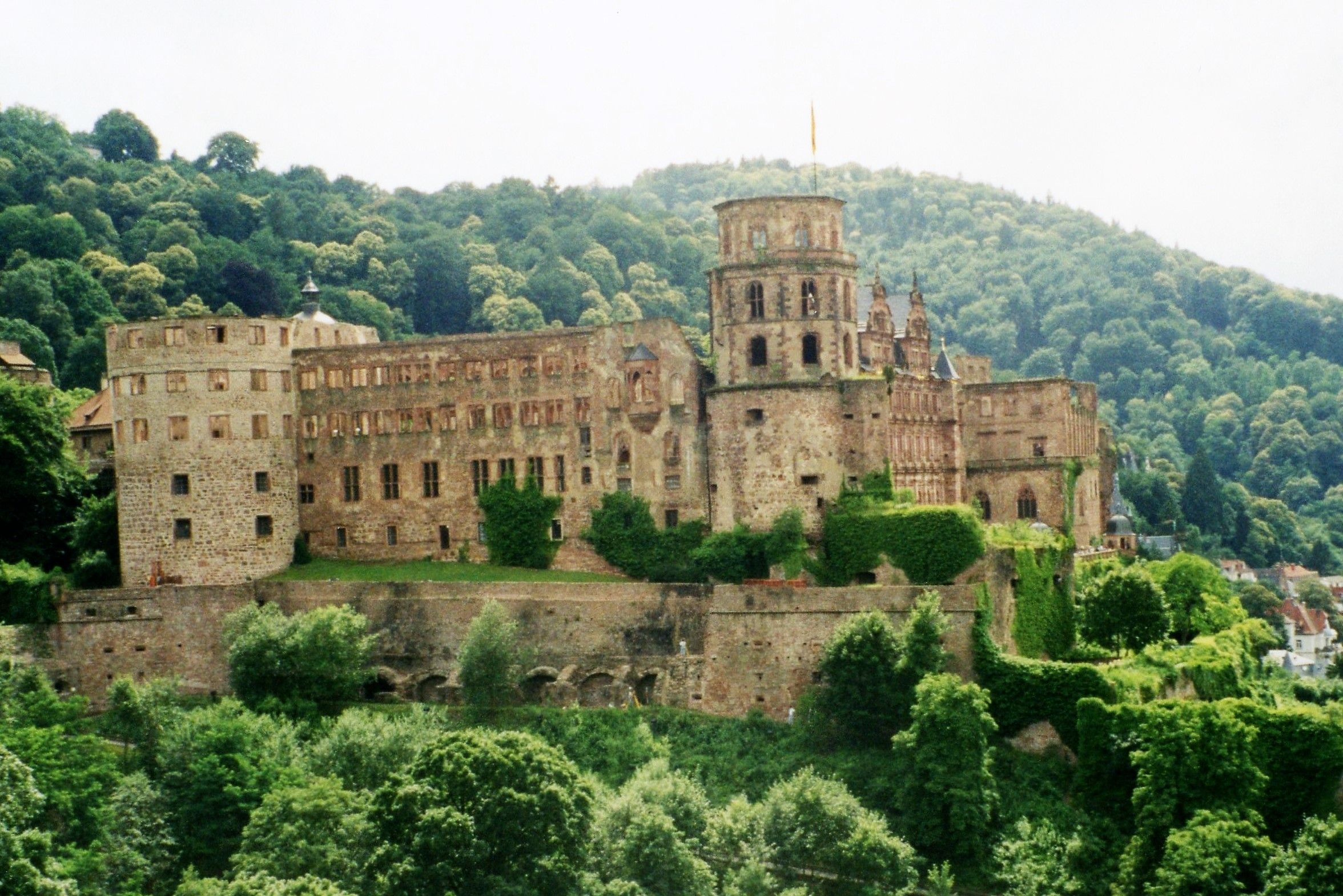
Where is Mörtelstein?
To locate Mörtelstein, we can start by drilling down through some maps. First, we see that Mörtelstein sits on the southwest side of a bend in the Neckar River.
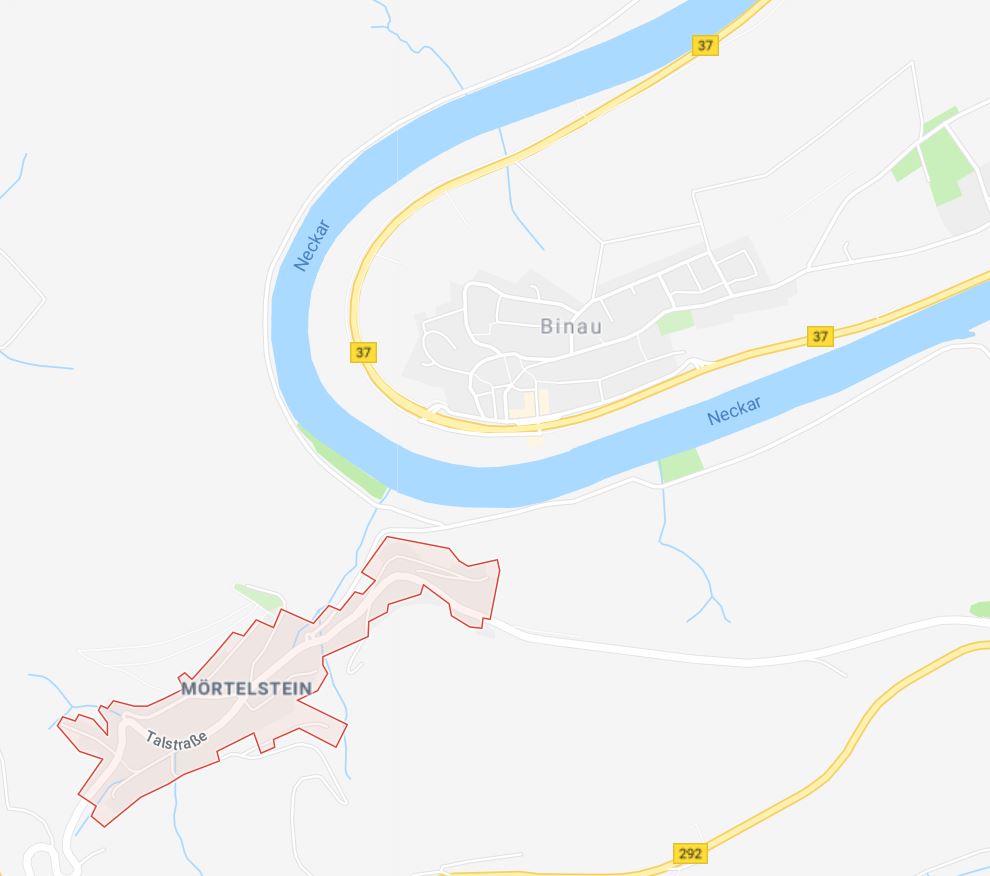
It is east of Heidelberg, Germany.
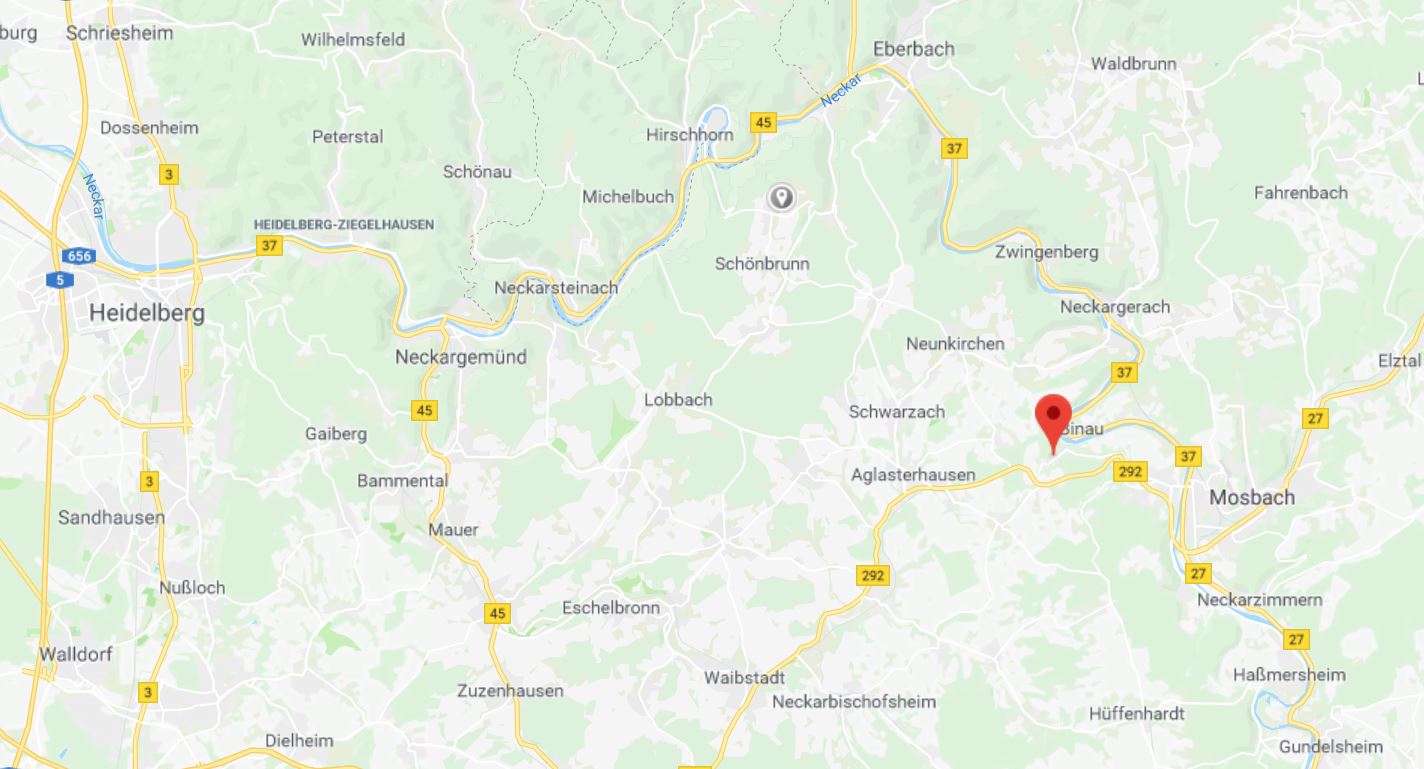

Mörtelstein is currently in the district of Neckar-Odenwald-Kreis which lies in the northern part of Baden-Württemberg.
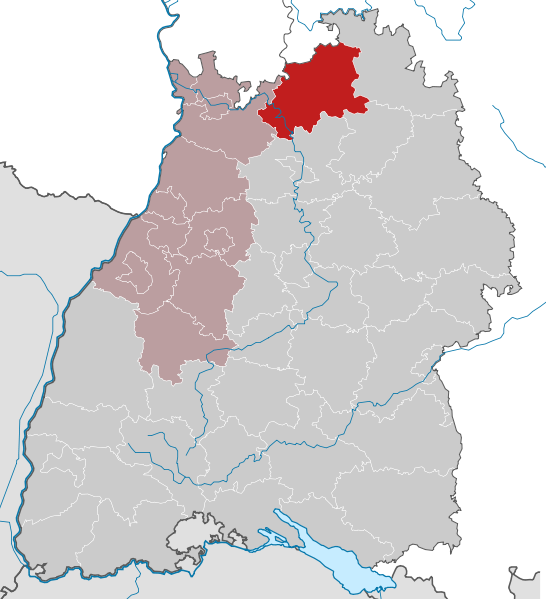
Baden-Württemberg is a parliamentary republic in the southwest part of Germany.
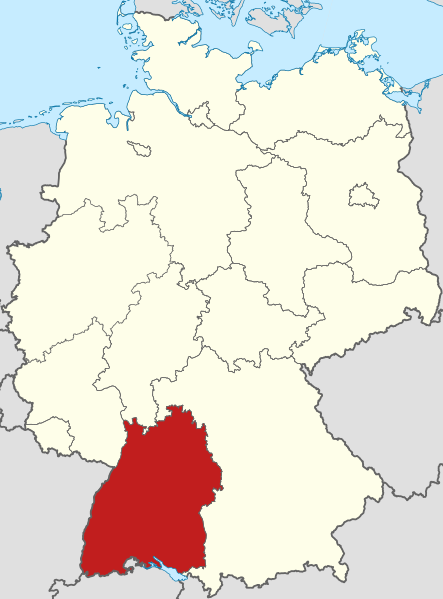
(Photo credit: TUBS, 2009. Wikipedia: https://de.wikipedia.org/wiki/Datei:Locator_map_Baden-W%C3%BCrttemberg_in_Germany.svg)
What was happening in Mörtelstein?
The previous maps show the current names of the places. But, when Georg was alive, things were different. In his time, Mörtelstein was located in the Grand Duchy of Baden. When the Holy Roman Empire dissolved between 1803-06, about the time of Georg’s birth, the Grand Duchy of Baden was enlarged and became a sovereign country. Charles Frederick, the Grand Duke of Baden had originally fought against the French during the French Revolution, but in 1805, had switched sides and fought for Napoleon. That led to more land being made a part of Baden. In 1806, the Grand Duke joined the Confederation of the Rhine and declared himself a sovereign prince. He continued to support France and, in 1809, was awarded even more territory. Under his reign, he quadrupled the area of Baden. When Charles Frederick died, his grandson, Charles, Grand Duke of Baden, succeeded him. He too fought for France until 1813 when he joined the Allies which included Austria, Prussia, Russia, the United Kingdom, Portugal, Sweden, and Spain. Note that Baden was not part of Germany. It was not part of Prussia. It was its own country, and remained so throughout Georg’s life. But, in 1815, during Georg’s youth, it did join the German Confederation.

When Baden joined the German Confederation, things were done hastily and there wasn’t a firm agreement on how succession would work when a ruling Grand Duke died or stepped down. This led to dispute. Grand Duke Louis I, who ruled from 1818 until 1830 was not popular. Government became dysfunctional. At one point, the Grand Duke dissolved the administration (the chamber) and levied taxes by his own authority.
In 1830, Louis I was succeeded by his half-brother, Grand Duke Leopold, who then ruled until 1852. Leopold was more liberal, and things seemed to be calmer in government. But, from about 1845 through 1849, Europe and what is now Germany, experienced several severe economic crises. The harvests in 1845 and 1846 were very poor and a potato blight decimated that crop. Because potatoes and grain were scarce, the price of basic commodities shot through the roof. People in both rural and urban areas were affected. Tens of thousands of people across Europe died of hunger and hundred of thousands of others left Europe in the first mass wave of emigration to the United States. Baden, where the Stadler family lived, was the center of revolutionist activities in 1848. Then in 1849, during the Baden Revolution, Baden became a republic for a short while, leaving the German Confederation. The Baden Revolution, though, was suppressed by Prussian troops. So Baden was still it’s own entity, but again part of the German Confederation.
With all the wars going on during Georg’s lifetime, it is quite likely (though not yet proven) that he had to serve in the military. We also don’t know what Georg did for a living. His work may have been tied to agriculture, which was very common then. But, instead he may have been a laborer. In 1849-55, only 54.6% of the German population was engaged in agriculture because the industrial revolution had already begun there. Baden didn’t have large deposits of coal and iron like other areas had, so industrialization was slower to happen there, but they did start doing light industry.
Very little is actually known about the details of Georg’s life!
Georg Adam Stadler died 31 Jan 1864 at Mörtelstein, Neckar-Odenwald-Kreis, Baden-Württemberg, Germany. He was buried there on 2 Feb 1864. He was 59-years old at the time of his death.
Where is he in the tree?
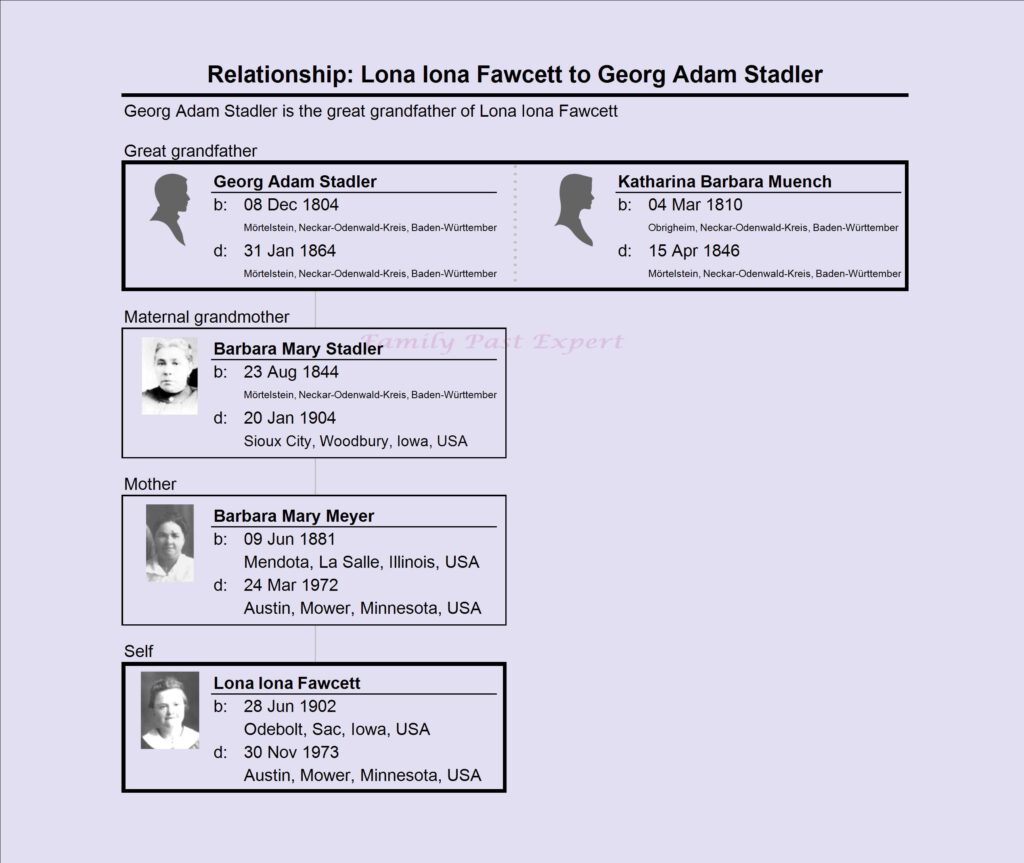
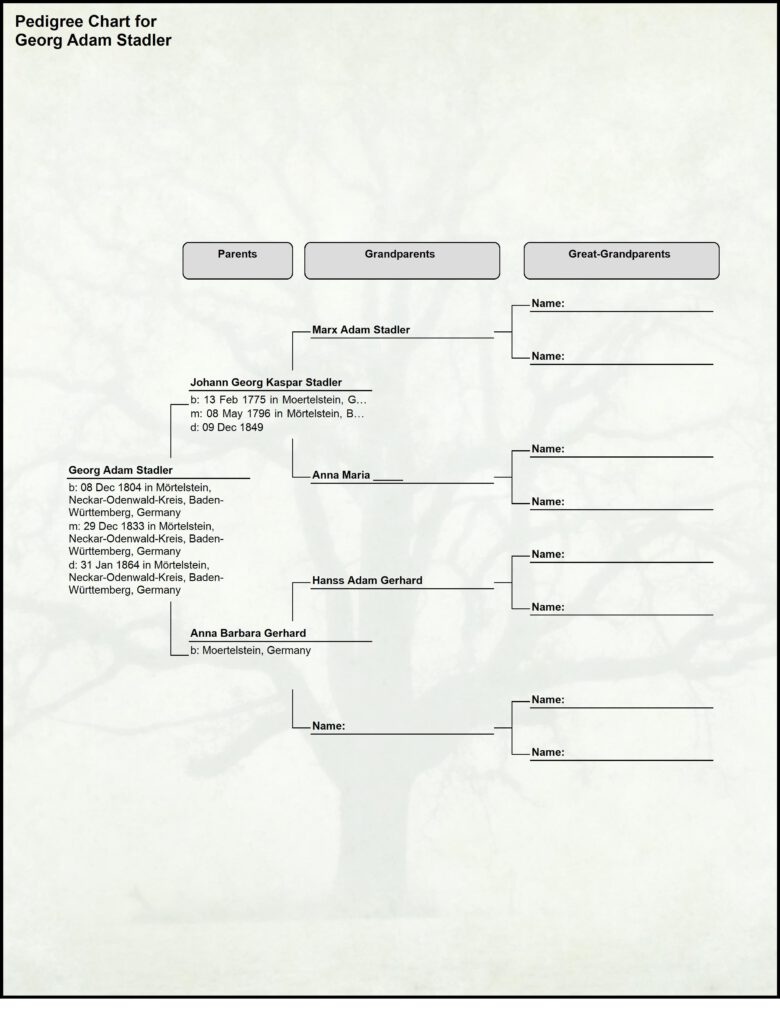
Selected sources:
Ancestry.com, Baden, Germany, Lutheran Baptisms, Marriages, and Burials, 1502-1985 (Provo, UT, USA, Ancestry.com Operations, Inc., 2016), ancestry.com.
Ancestry.com, Germany, Select Marriages, 1558-1929 (Provo, UT, USA, Ancestry.com Operations, Inc., 2014), Ancestry.com.
David Rubel, Webster’s 21st Century Concise Chronology of World History, 3000 BC – 1993 (Nashville: Thomas Nelson Publishers, 1993).
Grand Duchy of Baden, Wikipedia, Web, 5 Dec 2017, https://en.wikipedia.org/wiki/Grand_Duchy_of_Baden.
Prussia: Animated History (Part 2), YouTube, 4 Aug 2017, accessed 5 Dec 2017, https://www.youtube.com/watch?v=uAEJLrkfN4w.
Rüdiger Hachtmann, Economic Crisis in Germany, Web, 5 Dec 2017, https://www.ohio.edu/chastain/dh/econcris.htm.
Sophia Twarog, Heights and Living Standards in Germany, 1850-1939: The Case of Württemberg, Web, 6 Dec 2017, http://www.nber.org/chapters/c7434.pdf.


Leave a Reply